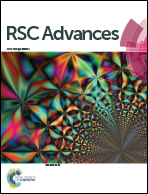Electron configuration-based neural network model to predict physicochemical properties of inorganic compounds†
Abstract
Registration, evaluation, and authorization of chemicals (REACH), the regulation of chemicals in use, imposes the characterization and report of the physicochemical properties of compounds. To cope with the financial burden of the experiments, the use of computational models is permitted for prediction of properties. Although a number of physicochemical property prediction models have been developed, their applicability domain is limited to organic molecules since most available data are concerned with organic molecules, and most of the molecular descriptors are restricted to organic molecule calculations. Prediction models developed for inorganic compounds were intended to predict endpoints relevant to novel material design. Therefore, no models were available for predicting endpoints of inorganic compounds that are significant to regulatory perspectives. In this study, boiling point, water solubility, melting point, and pyrolysis point prediction models were developed for inorganic compounds based on their composition. The electron configuration of each element in the molecule was used as a descriptor in this study. The dataset covered a wide range of endpoints and diverse elements in their structure. The performance of the models was measured using R2, mean absolute error, and Spearman's correlation coefficient, and indicated good prediction accuracy of continuous endpoints and prioritization of inorganic compounds.



 Please wait while we load your content...
Please wait while we load your content...